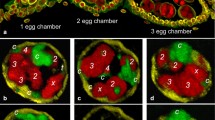Abstract
Prophase chromosomes of growing oocytes from thelytokous, viviparous females of Amphorophora tuberculata Brown and Blackman (n=2) were studied using a modified propionic acid squash technique with Feulgen staining. In early prophase, prior to the growth phase of the oocyte, the X chromosomes are partially condensed and looped together so that all four ends appear to be associated. Later in prophase the X chromosomes separate in oocytes destined to be female, but remain associated in presumptive male oocytes. The autosomes condense gradually throughout prophase. The nucleus of the presumptive male oocyte is further characterised by the formation of a spherical Feulgen-positive body, which attains a large size (7 μm diameter) in late prophase. At this stage, the X chromosomes are no longer visible as separate entities, and are apparently included in the spherical body. At metaphase this disappears, leaving the X chromosomes still united as a condensed bivalent. The spherical body seems to have nucleolar as well as chromatin constituents; nucleolar organisers are present at the ends of the X chromosomes where it first arises. It may function in maintaining the cohesion between the X chromosomes through prophase, and could also facilitate correct orientation of the X bivalent on the spindle of the maturation division. As sex determination in aphids is controlled by juvenile hormone concentration, it appears that the hormone may interact with the X chromosomes during prophase, bringing about their separation in female oocytes, perhaps by inhibiting the formation of the spherical body.
Similar content being viewed by others
References
Blackman RL (1978) Early development of the parthenogenetic egg in three species of aphids (Homoptera: Aphididae). Int J Insect Morphol Embryol 7:33–44
Brown PA, Blackman RL (1985) A new species of Amphorophora (Homoptera: Aphididae) on Geranium macrorrhizum in Britain. J Nat Hist 19:225–232
Hales DF, Mittler TE (1983) Precocene causes male determination in the aphid Myzus persicae. J Insect Physiol 29:819–823
Orlando E (1974) Sex determination in Megoura viciae Buckton (Homoptera, Aphididae). Monitore Zool Ital (NS) 8:61–70
Orlando E (1983) Chromosome abnormalities in males-producing eggs: a study of Megoura viciae (Homoptera, Aphididae). Genetica 62:55–59
Orlando E, Mari M (1968) Formazione e differenziazione della gonade femminile di Megoura viciae Buckt. (Hom., Aphid.). Atti Soc Nat Mat Modena 99:196–213
Oud JL, Reutlinger AHH (1981) The behaviour of silver-positive structures during meiotic prophase of male mice. Chromosoma 81:569–578
Virkki N (1984) Chromosomes in the evolution of Coleoptera. In Sharma AK, Sharma A (eds) Chromosomes in evolution of eukaryotic groups. Vol. 2. CRC Press, Boca Raton, pp 41–76
Author information
Authors and Affiliations
Rights and permissions
About this article
Cite this article
Blackman, R.L., Hales, D.F. Behaviour of the X chromosomes during growth and maturation of parthenogenetic eggs of Amphorophora tuberculata (Homoptera, Aphididae), in relation to sex determination. Chromosoma 94, 59–64 (1986). https://doi.org/10.1007/BF00293530
Received:
Revised:
Issue Date:
DOI: https://doi.org/10.1007/BF00293530




